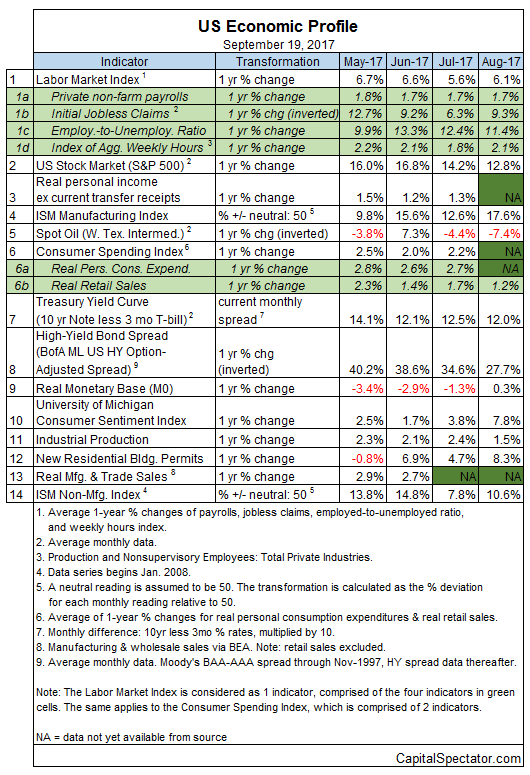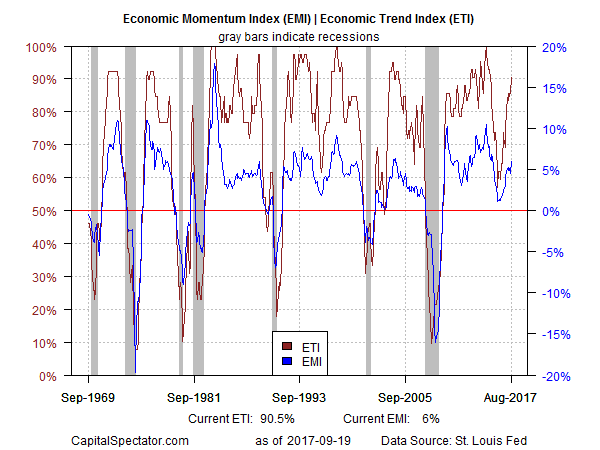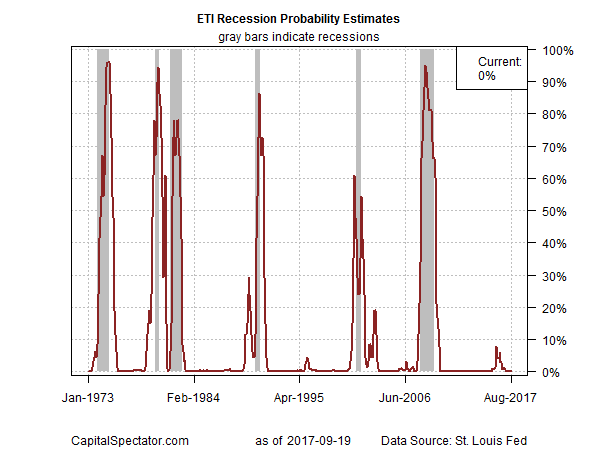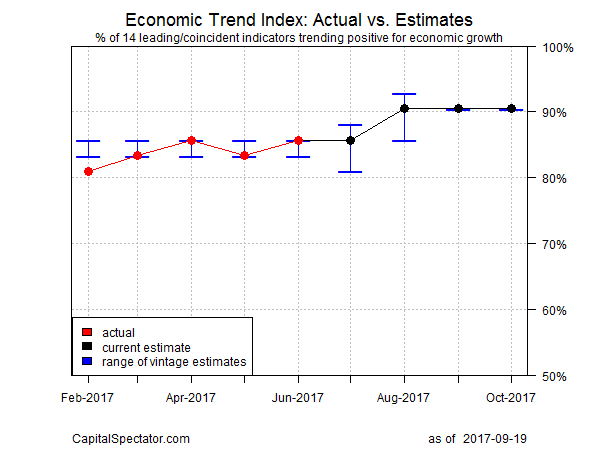Recent hurricanes have taken a bite out of US economic momentum, but the trend is only battered rather than broken. Surveying a broad set of indicators still points to moderate growth for the near term. Recession risk, in short, remains low for the US, based on the numbers published to date.
“It’s clear given [last week’s] revised numbers consumer spending won’t be as buoyant in the third quarter as it was in the second despite high consumer confidence and record-high stock prices,” noted Scott Anderson, Bank of the West’s chief economist.
Indeed, last week’s updates for industrial production and retail sales in August reflect a softer rate of growth. Housing starts also dipped last month. Note, however, that newly issued building permits for housing perked up to the highest level since January, a clue for anticipating that construction activity will strengthen in the months ahead.
Overall, it’s premature to see the latest weakness in some corners as the start of deeper trouble for the macro trend. Most indicators continue to trend positive for year-over-year changes and in some cases the pace has quickened. The annual rate of growth in the real monetary base has turned mildly positive for the first time in more than a year. In addition, the ISM Manufacturing Index firmed up in August to a six-year high.
The question is whether last month’s downside bias for the year-over-year growth rate in industrial activity and retail spending is a temporary setback? That’s the prevailing theory and one that’s supported by the moderately upbeat profile of economic activity for the US overall.
Forecasters have downgraded the outlook for second-quarter GDP growth to the low-2% range. CNBC’s latest survey (Sep. 19) of Wall Street economists shows a median estimate of 2.4% for Q3, down from 3.0% in Q2. Yesterday’s update of the Atlanta Fed’s GDPNow estimate for Q2 output is a bit softer at 2.2%.
In sum, there’s a case for managing expectations down vs. the month-ago review, but the downgrade still leaves growth projections at a moderate pace. The upbeat review is supported by the generally positive numbers for the nearly complete August economic profile, which remains encouraging in terms of positive year-over-year changes. (For a more comprehensive review of the macro trend on a weekly basis, see The US Business Cycle Risk Report.)

Aggregating the data in the table above continues to a reflect a positive bias overall. The Economic Trend and Momentum indices (ETI and EMI, respectively) remain well above their respective danger zones (50% for ETI and 0% for EMI). When/if the indexes slide below those tipping points, the drops will mark clear warning signs that recession risk is elevated and a new downturn is likely. The analysis is based on a methodology that’s profiled in my book on analyzing the business cycle.

Translating ETI’s historical values into recession-risk probabilities via a probit model also points to low business-cycle risk for the US through last month. Studying the data in this framework indicates that the odds remain close to zero that NBER will declare August as the start of a new recession.

For some insight on the immediate future, consider how ETI may evolve as new data is published. One way to project values for this index is with an econometric technique known as an autoregressive integrated moving average (ARIMA) model, based on calculations via the “forecast” package for R. The ARIMA model calculates the missing data points for each indicator for each month — in this case through October 2017. (Note that June 2017 is currently the latest month with a full set of published data). Based on today’s projections, ETI is expected to remain well above its danger zone through next month.

Forecasts are always suspect, but recent projections of ETI for the near-term future have proven to be reliable guesstimates vs. the full set of published numbers that followed. That’s not surprising, given ETI’s design to capture the broad trend based on multiple indicators. Predicting individual components, by contrast, is prone to greater uncertainty. The assumption here is that while any one forecast for a given indicator will likely be wrong, the errors may cancel out to some degree by aggregating a broad set of predictions. That’s a reasonable view, according to the generally accurate historical record for the ETI forecasts in recent years.
The current projections (the four black dots in the chart above) suggest that the economy will continue to expand. The chart above also includes the range of vintage ETI projections published on these pages in previous months (blue bars), which you can compare with the actual data (red dots) that followed, based on current numbers.
